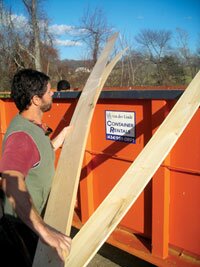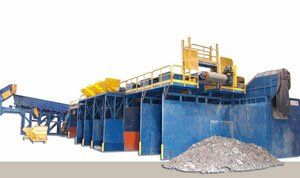GREEN- Easy buildin' green? Are local developers on the bandwagon?

Darrell Young goes rummaging through a big developer's refuse for perfectly good timber.
FILE PHOTO BY DAVE MCNAIR
Trifling with timber: Builders deep-six too much wood
A few months ago, local builder Darren Young and his helper were busy doing something builders do all the time– loading wood for a construction job onto his trailer. But this load of wood, approximately 60 16-foot pieces of cedar-beveled siding and base trim– an estimated $1,152 worth of materials– wasn't at a lumber yard; it was in a dumpster at the site of an upscale development just outside town.
"The construction manager there told me the wood was ruined, and I could have it if I wanted it," says Young, who moved his company, Willow Tree Construction, here from Seattle two years ago. "The only reason to throw away wood is if it's infested or rotten."
Young says the wood was fine and he's grateful to have it. He agreed to speak publicly about the issue on the condition that the Hook not reveal the location of the site.
"Go to some of the new housing developments," says Young, climbing into the dumpster, "and you'll find lots of good scraps."
Oddly enough, most of the houses in the upscale development had not been built: the sidewalks were in, street signs and lights were installed, but it was a neighborhood of staked-off dirt lots.
"I didn't come here looking for materials," says Young, "but I couldn't understand why they were throwing it away. It seemed so wasteful."
Indeed, why throw away all that wood?
"It's called capitalism," says Blake Caravati, a veteran builder and former City Council member. "Once that material hits the jobsite, if they don't need it, it's cheaper for them to get rid of it than it is to store it or try to recycle it. It's sad, but that's the way it is."
But brand new lumber?
"Unfortunately," says Charlottesville architect Gate Pratt, "the large-production builders build at such a scale that it wouldn't be worth the expense to recycle such a small amount of material. I don't know how you would prevent the waste short of mandated recycling."
One can imagine that having the general public picking through a construction site might not be the safest course. But Caravati also says that contractors are reluctant to let the public know about available materials on their sites for another liability reason.
"If someone uses a board taken from the site and it turns out to be inferior," he says, "who do you think is liable?"
What's more, says Caravati– who's skeptical of the so-called "green" building movement to begin with– it might actually be more "green" to throw the material away.
"To store or recycle that stuff," he explains, "you're going to need someone to come out and get it and haul it away, and then they're going to need to store it and process it."
Think of dozens of trucks and workers driving around picking up small loads of waste from job sites. Dealing with the construction waste that way actually creates a larger carbon footprint, says Caravati.
When a builder, especially a large builder, makes a new materials order, it all arrives at once by train, then delivery trucks make a trip, and that's it. What could be greener? Still, Caravati hates to see good materials end up in dumpsters.
"I don't know what the hell a 'green' builder is," he says, "but I learned things from my Mother, who grew up in the Depression and who saved and reused everything. I'm the same way. I save everything. Does that make me green? I don't know."
Of course, as a former Councilor and mayor, Caravati can't resist weighing in on the City's recently announced plan to build a living roof atop City Hall.
"It might feel good to put on that green roof," he says of the proposed $650,000 project, "but will it really do a damn? Why not invest in a geothermal heating and cooling system? That might be a better investment in the long run. The green roof is a political statement, not a carbon footprint statement."
Young appears to share Caravati's skepticism. "For many businesses," he says, sliding a painted piece of trim onto his trailer, "the green movement is just a play on words."
Politics and virtue aside, architect Jeff Sties, a member of the Charlottesville chapter of the James River Green Building Council, says there has always been an "enormous amount of waste" in both commercial and residential construction. According to EPA estimates, he says, 136 million tons of construction and demolition debris was generated in 1996, the majority of which could have potentially been recycled.
Among the reasons it was deep-sixed: preventing delays, saving on storage costs, and avoiding the hassle of performing a "cut list," a list of wood materials and how they are to be cut up for use on the job. Then there's the fact that many suppliers charge hefty restocking fees on returned materials– or refuse to accept returns altogether.
"In my opinion," says Sties, "the way to reduce waste is to offer incentives to builders who implement the LEED rating system– and at the same time increase fees associated with dumping."
For example, Sties says that under the Materials and Resources section of the LEED rating system (the standard for builders seeking green street cred), builders can get one point for diverting 50 percent of their construction waste from a landfill to another source such as a Habitat Store or a recycling center, and an additional point for diverting 75 percent.
"But not having a project team interested in construction waste and recycling to begin with is the real problem," says Sties.
"Recycling here is a real pain in the butt," says Young, wiping his forehead and pulling the last of his free lumber from the dumpster, as he recalls how discards are handled in his old hometown.
"In Seattle, people are given 55-gallon containers with wheels to put their recyclables in," he says. "The trash cans are small and the recycling bins are big– it's just the opposite here.
"Don't get me wrong," he quickly adds. "Any effort is good, but there are better ways to do it."

Might this be the way Charlottesville builders recycle in the not-so-distant future?COURTESY OF PETER VAN DER LINDE
Coming soon! van der Linde's amazing recycling machine!
Local builder and businessman Peter van der Linde couldn't agree more.
"People have lived for years in recycling frustration," says van der Linde, who also owns a trash container business. In fact, the dumpster Young went diving into belongs to Van der Linde Container Rentals. "It's a pain in the... neck."
As a builder for 30 years, he also agrees with Young about the volume of materials discarded on job-sites. "It's always been a big problem," he says.
Three years ago, van der Linde decided to do something about it. On a 10-acre tract of land near Zion Crossroads, he plans to finally open a $10-million, 100,000-square-foot recycling center, featuring a 270-foot state-of-the-art sorting machine, which should be operational in mid-May.
"This will be the opposite of the way it's done now," he says. "You'll just throw everything into one container, no need to separate or sort it. You don't need to lift a finger. We'll do it."
He pauses for emphasis.
"Now, everything changes, now recycling is easy," he says.
Indeed, while both the city and the county offer recycling services, the activity is nearly a full-time job. In addition to sorting and separating glass, metal, aluminum cans, newspapers, magazines, and catalogs for the city's curbside service, telephone books, file stock, and mixed paper must be taken to the McIntire Road Recycling Center. In 2003, the County stopped its curbside recycling service because it had become too expensive. In its absence, the Rivanna Solid Waste Authority published a guide directing folks to different facilities for different materials, many of which can be dropped off only at certain times. The recycling guide is three single-spaced pages long.
In contrast, van der Linde says his recycling machine can can sort 15 separate recyclable materials, including cardboard, paper, plastic, cement, carpet and pad, glass, metals, brick, block, yard waste, wood, drywall, asphalt, even styrofoam. And anything intact will be sent to Habitat for Humanity.
"This machine will recycle 90 percent of what goes into it," he says.
Indeed, the new venture will make it especially easy for all those developments tossing good lumber into his dumpsters. "Don't change anything you're doing," he says he'll tell builders. "It's business as usual. Just toss it all in there, and we'll sort it."
"Our lives just got a lot easier" says Alec Cargile, president of Lithic Construction, who says he's been waiting for someone to do this for years. "It's fantastic what he's doing, because for anyone who chooses to use this service, it will now be effortless to recycle."
"I think it's a terrific idea because he's using the same containers he's already using, and he already has his disposal business in place," says Ned Ormsby, a project manager with Lithic. "There's no need to retrain your guys; you just toss it all in there."
"I think it's a powerful thing he's doing," Cargile adds. "If people really start using his service, it could have a huge impact on the whole county."
Van der Linde says he'll rent various container sizes without charge to neighborhoods, schools, municipalities, or anyone else who wants one nearby, and then charge a standard transportation and tonnage fee. Additionally, there will be no-charge drop-off containers at the facility itself.
As for his spectacular machine, van der Linde says it was the missing link, as inferior machines and hand-sorting trash has been wildly inefficient. "In the last seven years or so, these separation machines have really been perfected," he says. "I did a lot of research on them, and I believe this one I bought is the ultimate machine."
Nearly the size of a small shopping center, the machine and the new facility will require 15 people to operate, he says. Manufactured by Sherbrooke Ltd., a Canadian company, the new machine uses optics, electromagnets, and other technologies to identify objects to be recycled. The machine can sort and separate recyclables from thousands of pounds of trash in a fraction of the time it would take to hand sort, and it deposits them neatly in separate bins. According to industry experts, the machine's ability to yield more recyclable materials faster could begin to make recycling profitable.
"There's a rapidly emerging market for recyclables," van der Linde says. "I'll just offer to supply the materials and then we'll have to see what happens."
Clearly, the idea of responding to Young's lament– and that of frustrated recyclers everywhere– appears to be worth the risk for van der Linde.
"It's just something that's long overdue," he says. "It's a real feel-good undertaking."

"When you have a personal connection, people are more likely to change," says Terri Kent, seen here with her son Ian.PHOTO COURTESY OF TERRI KENT
Better with Betty! Website aims to simplify recycling
With van der Linde's recycling machine not slated to be up and running until May, we're facing several more months of separating cans and paper and glass. And even when it's operational, what are we going to do with that old bag of shoes, that smashed sliding glass door, and that broken washing machine?
Well, duh! Ask Betty!
"People kept telling me about all the piles of recyclables they had lying around at home," says Teri Kent, a former teacher and stay-at-home mom, "and I started putting my own life under the microscope. What can I do to help them and help the environment?"
Inspired by the Better World Handbook, a kind of Activism for Dummies that provides simple, practical ways for busy folks to change the world, Kent launched a website in January called Better World Betty (betterworldbetty.com). The site introduces us to the character of Betty, a kind of perfectly coifed June Cleaver– out not to bake the perfect pie and send her family pressed and neat off to work and school, but to save the planet.
"She tends to the Earth, bringing a better world to the table," writes Kent on her website, "rather than a big roast turkey."
In Kent's mind, the idea of recycling had become too abstract, too clinical, and, well, not very fun. Creating Betty was a way to make it personal.
"When you have a personal connection, people are more likely to change," she says.
Indeed, right from the get-go, Betty began charming local greenies, including former Mayor David Brown, who seemed smitten writing about Betty on his blog in January.
"Kudos to Teri Kent for this useful and charming website," he wrote, mentioning the City's new Green City Initiative website, but adding that it was "not quite as cool as Betty, though."
In January alone, says Kent, the site saw 1,700 users, 25,000 hits, and most important– 65 percent of people who visited bookmarked it.
Current mayor Dave Norris was charmed as well: he helped organize the simultaneous launch of Better World Betty and the city's site.
"I've talked with her several times about this, and I think it's a good thing," Norris says. "It's one more component in moving our community in the direction of lessening its impact on the environment."
Though Kent already has plans to revamp Betty (no, she's not changing it to Better World Angelina)– giving her an improved directory and more intuitive site functionality, forums, and video presentations– the current directory allows visitors to find out where to recycle everything from toasters to toothbrushes, anti-freeze, backpacks, and batteries. It also has a list of businesses that go the extra green mile, an "Ask Betty" feature where recycling questions are answered, and a whole host of green living tips and information.
"A lot of people talk about change," says Kent, "but I'm big on action. Betty makes it easier to live greener better by giving people the tools they need."
The beauty of Betty, Kent emphasizes, is that site users don't have to be perfect. Instead, the queen of green advocates an incremental approach. "The small things that people decide to do add up," she says.
Ideally, Kent hopes the website helps connect people with the right choices, and eventually, with each other.
"I'd like to create a community where people can share ideas," she says, "like what to do with old sponges or bags of worn shoes. There are so many great ideas out there about how to recycle and reuse. People just don't know about them."
Indeed, Kent believes education is key to living greener better. For example, how many of us know what gets done with the things we take the effort to recycle?
"This has always been somewhat controversial," says Kent. "Does what you recycle really get used?" [See the Hook's cover story, "(Re)cycle of life: We want to believe," February 8, 2007].
Again, the more informed people are, the more likely the system will improve.
"That's the hardest thing, closing the loop, so that materials don't just end up sitting in a landfill," says Kent. "But it's difficult. For example, plastics need to be collected in really high volumes, with good quality, to make it profitable to recycle. People need to know that they can make money salvaging materials. "
Although unaware of van der Linde's planned recycling project– a $10 million state-of-the-art sorter and sorting facility near Zion Crossroad that will use various technologies to separate up to 15 recyclable materials– Kent says it's exactly the kind of effort that can close the loop. Indeed, as van der Linde recently mentioned, a market for recyclables is slowly emerging, but the situation is not likely to get better until there's more demand.
That might happen, if Kent has her way, when the world will be full of Bettys.
#